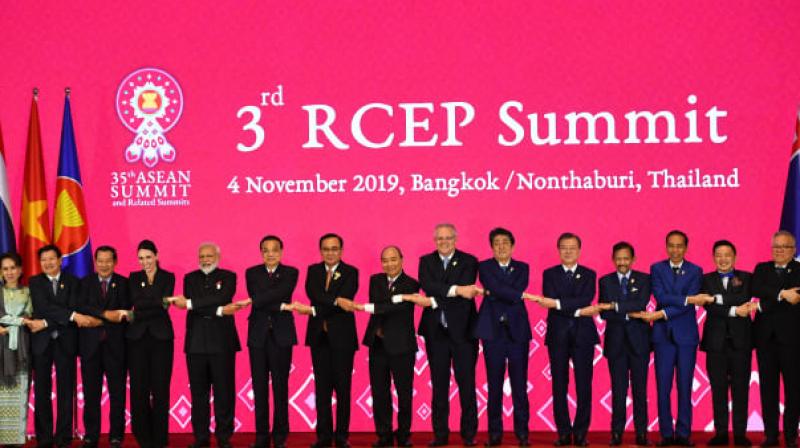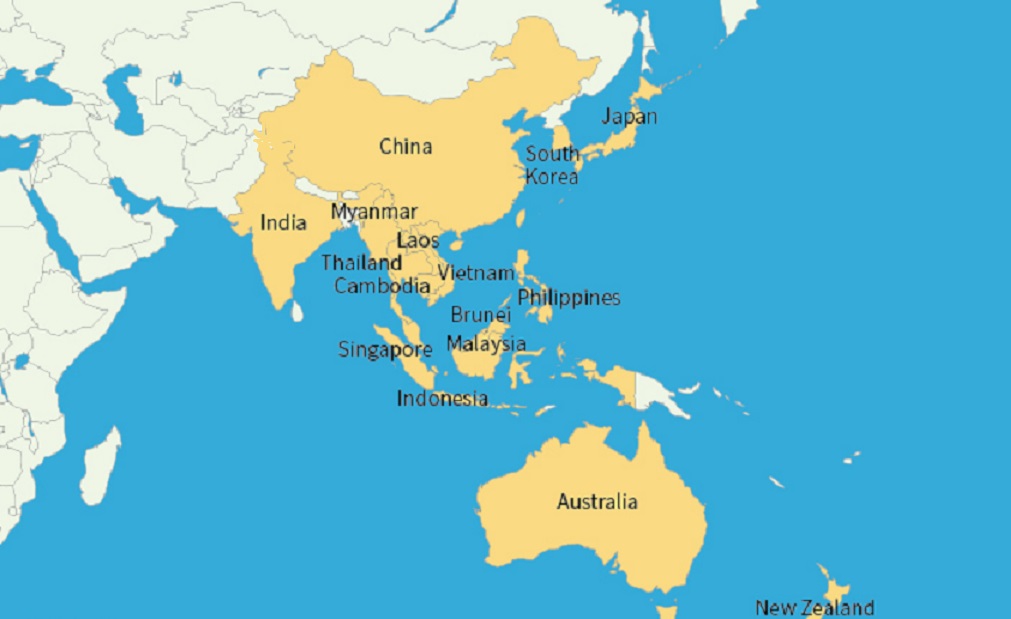Regional Comprehensive Economic Partnership (RCEP) is a trade agreement between the member states of the Association of Southeast Asian Nations (ASEAN) and its free trade agreement partners.
In Part-1 of the article we examined the need for economic partnership agreements, RCEP –its scope, negotiations process, reasons for India walking out of Regional Comprehensive Economic Partnership. In Part-2, we would focus on impacts on India, further steps for India, a conclusion and some suggestions.
Implications for India
It’s a stark reality that India’s decision to refrain from joining the Regional Comprehensive Economic Partnership is going to cost it both geo-politically and economically. There are concerns that India’s decision would impact its bilateral trade ties with RCEP member nations, as they may now be more inclined to focus on bolstering economic ties within the bloc. The non-participation may potentially leave India with less scope to tap the large market that Regional Comprehensive Economic Partnership presents, accounting for over 2 billion of the world’s population.
In view of the attempts by countries like Japan to get India back into the deal, there are also worries that India’s decision could impact the Australia-India-Japan network in the Indo-Pacific. It could potentially put a spanner in the works on informal talks to promote a Supply Chain Resilience Initiative among the three. Biswajit Dhar, JUNU Professor and a trade expert said on the subject that:
You don’t get into FTAs merely to provide your market to your partner countries. While you accommodate your partner countries, your objective is also to increase the presence of your products in the markets of your partners, and India hasn’t been able to achieve the latter objective. Our share in the imports of RCEP partner countries has either stagnated or fallen.
(Source: Raghavan, 2020)
Another study has confirmed the analysis by bringing out that India pulled out of the China-backed trade agreement as negotiations failed to address its core concerns. These were threats of circumvention of rules of origin due to tariff differential, the inclusion of fair agreement to address the issues of trade deficits and opening of services. The deal could have resulted in a flood of imports, especially from China increasing its trade deficit. India’s trade deficit with other RCEP countries was also rising.
As far as implications the study has opined that:
India might lose investments while its consumers may end up paying more than they should, especially when global trade, investment and supply chains face unprecedented challenges due to the Covid-19 pandemic. Countries in the RCEP agreement would also lose out on an opportunity to access the Indian market that is notoriously hard to get into especially during the current global economic situation.
(Source: ETOnline, 2020)
Should India Have Joined the RCEP ?
After examining the reasons for India keeping out RCEP and its implications for India, it would be important to analyse counter views on the subject.
There are expert opinions about why India should have signed the RCEP. One study has observed that despite the shortcomings, India should have signed the RCEP. This could have enabled it to influence the institutional policies of regional trade, which will shape the future of regional trade. This could have been worthwhile despite accepting certain costs in the short term.
Being a member of RCEP would have kept India at par with the regional and global value chains and allowed it to strengthen economic growth through an established trading system. Even during the waves of nationalism and protectionism in the world, the East Asian economies have been dynamic and have adapted preferential routes and engagement in mega-regional agreements. Owing to the presence of robust production and supply chains in Northeast and Southeast Asian countries, the regional value chains among the RCEP members are expected to be very close-knit.
Other than the economic perspective, signing the RCEP would have benefitted India with political and geopolitical value attached to it. This would have signalled India’s commitment to trade liberalisation and regional integration in the midst of the pandemic (Bhutani, 2021).

Way Forward- Reasons for India’s Cautionary Approach to Joining RCEP
India since the beginning of this century has signed a host of FTAs and comprehensive economic cooperation agreements (CECAs) which also include investment agreements. A large part of them has been with the Southeast Asian nations. Factually, India’s trade deficit went up after entering into FTAs and CECAs. As far as China is concerned, India faces a massive and growing trade deficit. It is thus clear that by signing a multilateral RTA where China is a signatory, imports would have further increased by a higher magnitude than exports due to price competitiveness. Indeed, demand for imported commodities has increased, thus far with a decline in or complete elimination of tariffs and non-tariff barriers. This has negatively affected domestic industry, as seen in the sectors of edible oil processing, automobiles, electronics, telecom and white goods (Ghosh, 2020). At the same time, however, these RTAs have widened choices of cheaper products for Indian consumers.
It has also been observed that though the regional economic integration processes would have been natural choices conducive for the flagship ‘Make in India’ ambition, this might not be the case with RCEP, as there are many other concerns that remain, especially on the market access with services.
India already has bilateral trade agreements with most of the RCEP members and it is negotiating trade deals with Australia and New Zealand. Thus India’s participation in RCEP needs to be seen whether India and China can have a mutually beneficial relationship through international trade and investment
Seen from an economic perspective, it is important for the policymakers involved in RTAs to evaluate the potential trade-offs between the key stakeholders of the economy, including consumer benefits and producer surplus or domestic industries. Further, a crucial concern is that a rising bilateral trade deficit is very real taking into account India’s experience with Southeast Asian nations.
In view of the above, it’s clear that an optimal decision cannot be reached only with a comprehensive feasibility study that examines not only the macro-economic impacts (through macro-variables and multiplier impacts on GDP), but also the impacts on the product value chain.
There are cogent reasons to believe that regional trade agreements like the RCEP need not always be beneficial from the ‘Make in India’ perspective. While ‘Make in India’ is the flagship project to attract foreign investment, it was not conceived at the cost of domestic industry. Even after more than a quarter of a century of economic reforms, Indian manufacturing is yet to mature to be competitive enough to face the vagaries of competition brought about by international trade.
Another important factor that cannot be ignored is that despite low relative labour cost, India’s labour productivity is still one of the lowest in the world, and spatially fragmented labour laws escalate the costs of the transaction. Under such circumstances, the Indian industry is hardly in a position to compete in a level playing ground in a free-trade region.
Further, the reluctance of RCEP Partners in liberalising aspects related to ‘services’ has been a thorny issue from the Indian perspective. In the cases of FTAs with East and Southeast Asian economies, beginning with Singapore in 2005 to the last one signed with South Korea in 2011, India has been n insisting on capitalizing on its pool of ‘skilled’ labour force to gain from improved access to employment opportunities in these economies.
Last but not the least, it has been feared the RCEP may go far beyond trade liberalization, in the long run. RCEP its attempt to harmonize foreign investment rules, IPR laws and several other laws and standards beyond what has been agreed by developing countries at the WTO, may take away an economy’s ability to customize trade policies according to the needs of specific time periods. This will be another long-term cost that the Indian economy may need to bear (Ghosh, 2020a).
There is no doubt that RCEP has been the first mega-trade deal of such comprehensive nature that India need to engage with. From that perspective, India needs to carve out its cautionary approach taking into account all the costs of joining RCEP. Now that bilateral negotiations are being pursued under the umbrella, India has to find the right equation to extract the maximum benefits from this mega-trade deal. The challenges are huge, but so are the opportunities, if analysed and implemented in the right way. In the words of Wignaraja (Wignaraja, 2018):
Building business competitiveness and bringing policy reforms can mitigate large parts of the challenges brought about by RCEP, and convert them to opportunities. It needs to be kept in mind that in terms of ease of doing business index, with the exception of Cambodia, Lao PDR, and the Philippines, all other nations rank higher than India, and hence can boast of better business conditions for attracting investments.
Thus a cautionary approach towards RCEP is the best way forward for India.
Conclusion
India currently stands in an unenviable situation with the stressed economy, pandemic effects, effects of Belt and Road Initiative ( BRI) and its debt trap for India’s neighbours, China Pakistan Economic Corridor ( CPEC) and its current chaotic status and its China-related border and IOR problems. Thus it’s important that India revives its economy of fast track. RECP may help in that aspect. However, India needs to:
- Do a more holistic cost-benefit analysis with a view to understanding the potential impacts of the RCEP on India, both from the economic and political perspectives.
- Analyse critical questions related to complementarities in trade negotiations, costs and benefits of standardized IPR regimes, as well as the impacts on the product value chain.
- Prepare a comprehensive matrix on the benefits and costs at spatial and temporal scales of India’s participation in the RCEP.
- Till India properly comprehends the potential benefits, costs, and the associated threats including the geostrategic concerns, India should refrain from signing the RCEP.
Fortunately, India has been given the time to rethink its decision. This is because RCEP without India would be incomplete. Since India is the only South Asian country that is part of the South Asian Free Trade Agreement (SAFTA) and has an FTA with ASEAN, India would have been the gateway for other RCEP member countries in the South Asia region through multilateral trading agreements.
For now, it sure looks like India might have missed the chance to access a huge part of the North and Southeast Asian markets and vice versa. However, the utility of not signing the RCEP would be evident in India ability to align the goals of foreign trade policy (2021-2025) with ‘Atmanirbhar Bharat,’ capitalise on the Make in India initiative and progressively cut down the trade deficit with the Regional Comprehensive Economic Partnership member countries in the coming years.
Finally it is suggested that in addition to the above India also need to consider:-
- Improving its bilateral geo-politico-economic-cultural ties with the ASEAN and BIMSTC countries and use the combined strength to address its concerns related to RCEP.
- Reduce internal strife and create a favourable atmosphere for attracting FDI.
- Improve its ranking in ‘Ease of Doing Business’ aspects.
- Put in place measures to upskill its labour force and improve labour productivity.
- Improve its employment laws and practices.
A few concerns which would need to be researched further would pertain to:-
- Impact of change in USA’s trade policies towards China.
- Impact of USA and UK joining the Comprehensive and Progressive Agreement Trance Pacific Partnership (CPTPP).
Let us hope India would be able to negotiate the difficult challenges and succeed in occupying its rightful place in the region. Jai Hind.
References:
1. ILO Paper (ND), ILO, Local Economic Development (LED), Retrieved from: http://www.ilo.org/empent/areas/local-economicdevelopment-led/lang–en/index.htm, Accessed on 27-28 Mar 2021
2. Report on Employment and Economic Development, 2006, OECD, Local Employment and Economic Development (LEED Programme), Retrieved from: http://www.oecd.org/employment/leed/
3. Bruce Andy and ChopraToby, (2021), Reuters, UK Set to Formally Apply for Trans Pacific Trade Bloc Membership, Retrieved from: https://www.reuters.com/article/us-britain-trade-cptpp/uk-set-to-formally-apply-for-trans- pacific-trade-bloc-membership-idUSKBN29Z0W1, Accessed on 04-05 Feb 2021
4. Coetzee Clive, Oct 2014, Researchgate, Successful Partnerships for Economic Development, retrieved from: https://www.researchgate.net/publication/271967113_Successful_Partnerships_for_Economic_Development. Accessed on 28 Mar 2021
5. Buuren Lotte Van (2015), CIVITAS Institute for the Study of Civil Society 2015, Retrieved from:
a) http://www.civitas.org.uk/eufacts/index
b) https://www.civitas.org.uk/content/files/EX.9.EPAs_.pdf
Accessed on 27-28 Mar 2021
6. Staff Reporter (2020), National News, What is the RCEP and why is it important? Retrieved from: https://www.thenationalnews.com/business/economy/what-is-the-rcep-and-why-is-it-important-1.1111641, accessed on 27-28 mar 2021
7. Cali Massimiliano (2020), Brookings, The significance of the Regional Economic Partnership Agreement, retrieved from: https://www.brookings.edu/blog/future-development/2020/11/20/the-significance-of-the-regional-economic-partnership-agreement/, accessed on 28-29 Mar 2021
8. Bird Mike (2019), Wall Street Journal, Asia’s Huge Trade Pact Is a Paper Tiger in the Making, Retrieved From: https://www.wsj.com/articles/asias-huge-trade-pact-is-a-paper-tiger-in-the-making-1157294388, accessed on 24 Apr 2021
9. Hoi DL J (2019), UNCTAD, ASEAN Investment Report 2019, Retrieved from: https://unctad.org/webflyer/asean-investment-report-2019, accessed on 28 mar 2021
10. Seymour Hugo and Wilson Jeffrey (2019/a), Researchgate, RCEP: RCEP: An economic architecture for the Indo-Pacific? Retrieved from: https://www.orfonline.org/expert-speak/rcep-an-economic-architecture-for-the-indo-pacific-57242/, accessed on 27-28 Mar 2021
11. Raghavan Prabha (2020), Indian Express, Explained: The economic implications of India opting out of RCEP, Retrieved from: https://indianexpress.com/article/explained/india-out-of-rcep-china-economy-trade-angle-7053877/, accessed on 27-28 Mar 2021
12. Staff Reporter (2020), Economic Times, Why did India opt out of RCEP, one of the world’s largest free trade agreements? Retrieved from: https://economictimes.indiatimes.com/news/economy/foreign-trade/why-did-india-opt-out-of-rcep-one-of-the-worlds-largest-free-trade-agreements/massive-free-trade-agreement/slideshow/79246185.cms, Accessed on 27-28 Mar 2021
13. Bhutani Akarsh (2021), Observer Research Foundation, India’s reluctance in joining the RCEP — A boon or a bane in the long-run? Retrieved from: https://www.orfonline.org/expert-speak/india-reluctance-joining-rcep-boon-bane-long-run/, Accessed on 27-28 Mar 2021
14. Ghosh Niranjan (2020), Researchgate, Regional Comprehensive Economic Partnership Issues and Concerns for India, Retrieved from: https://www.researchgate.net/publication/344951357_Regional_Comprehensive_Economic_Partnership_Issues_and_Concerns_for_India. Accessed on 27-28 Mar 2021
15.Wignaraja Ganeshan (2018), Asia-Pacific Research and Training Network on Trade ( ARTNeT, What does RCEP mean for insiders and outsiders? The Experience of India and Sri Lanka, Retrieved from: https://www.unescap.org/sites/default/files/AWP%20181_Formatted.pdf, Accessed on 27-28 Mar 2021.
Disclaimer: The views and opinions expressed by the author do not necessarily reflect the views of the Government of India and Defence Research and Studies
Title image courtesy: https://www.caixinglobal.com/2017-02-21/





